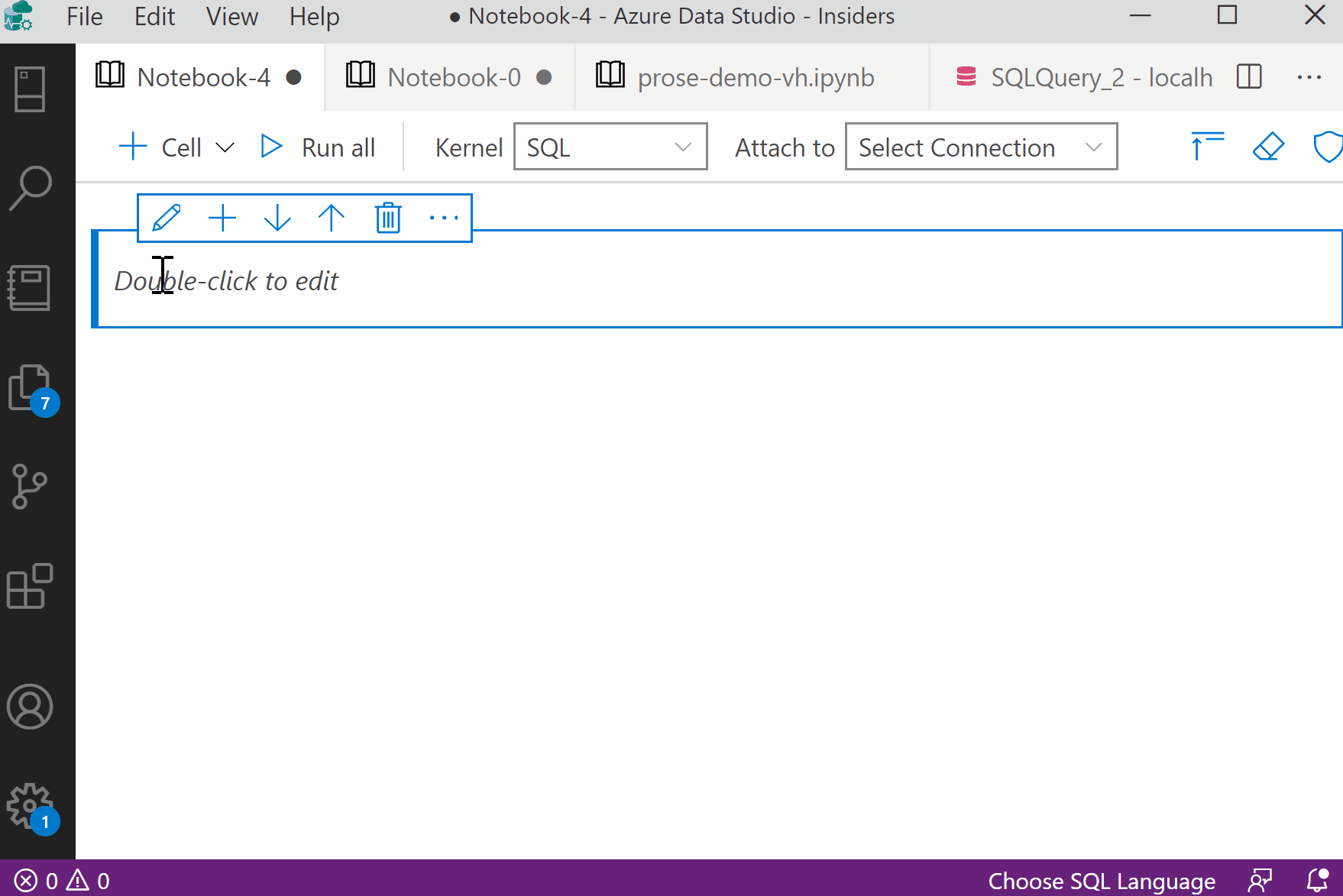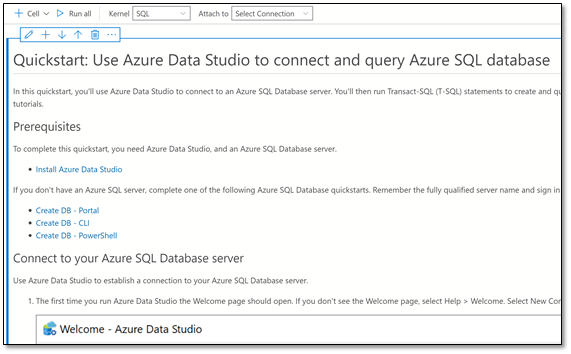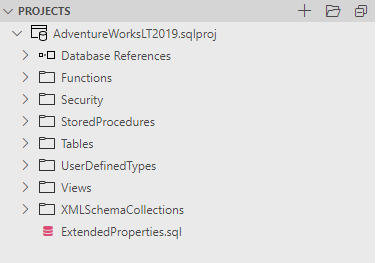The September 2020 release of Azure Data Studio is now available
The September release of Azure Data Studio is now available. Download Azure Data Studio and review the release notes to get started.
Azure Data Studio is a multi-database, cross-platform desktop environment for data professionals using the Microsoft family of on-premises and cloud data platforms on Windows, MacOS, and Linux. To learn more, visit our GitHub.
The key highlights to cover this month include:
- Announcing new Notebooks features:
- Rich Text Mode
- Double click to edit
- Pinning
- New Jupyter Books support
- Performance
- Announcing public preview of SQL Database Projects extension.
- Announcing public preview of Kusto (KQL) extension.
- Announcing Azure Arc preview support.
- Announcing Azure SQL Edge general availability support.
- Announcing the general availability of Import extension.
- Try out new templates in extension generator.
- Bug fixes.
- Azure Data Studio community call.
For a list of complete updates, refer to the Azure Data Studio release notes.
New Notebook features
Rich Text Mode / WYSIWYG
When trying out notebooks for the first time, many users were not familiar with Markdown, or users would always have to look up the syntax. Over time, we added a Markdown toolbar to help make it easier to remember Markdown syntax, which made many users happy, but we thought we could do even better. We wanted to make it as easy to write in notebook text cells as you would in an email or typing a document.
Through embracing hackathons and open source, and driven by the passion to do more for our users, we are excited to announce Rich Text Mode, also known as WYSIWYG Mode (what-you-see-is-what-you-get).

For the first time, notebook users no longer need to know Markdown in order to create text cells. Simply start typing and interact with the toolbar as if you were using a typical text editor. This means support for headers, bold, highlighting, images, and more.
That’s not all, as you type, we will dynamically convert your text into Markdown, which you can see by switching to Split or Markdown view. This ensures we don’t break any backward compatibility with other Jupyter Notebook viewers while giving you a world-class editing experience inside of Azure Data Studio.

This dynamic converting takes it one step further with copy and paste interactions. You can now copy and paste images/gifs locally or from online, and we will seamlessly convert the markdown for you behind the scenes.
Finally, you can try copying entire web pages, OneNote pages, and more, and those too can be converted into markdown and retain the formatting in the Notebook.

This is one of the most innovative features we have brought to notebooks, and we are excited to share this experience that we envisioned for so long.
Double click to enter edit text cell
A feature that was highly requested to bring back was having the ability to double click on a text cell to enter edit mode. We are excited to announce this feature is back in the product. This should help make it even easier for you to create or edit a notebook and dive right into Rich Text Mode.
Pinning notebooks
Have you ever wanted to pin notebooks that you find yourself running all the time? Now you can in the Notebooks viewlet in Azure Data Studio. Once you view your notebooks in the viewlet, you can now hover and pin any notebook in the Pinned notebooks sections. This is a great way to be able to quickly access your favorite notebooks.

Supports new versions of Jupyter Books
The September release now supports the new version of Jupyter Books (> v0.7.0). This means you can view, edit, and create all versions of Jupyter Books in Azure Data Studio. We will continue to support older versions of Jupyter Books, although we highly encourage users to start creating Jupyter Books with the new version.
Check out the announcement blog to learn more.
Notebook performance
SQL Notebooks now supports streaming of results for long queries. This significantly decreases the time it takes for a user to start seeing data after running a T-SQL cell.
Announcing preview of SQL Database Projects extension
SQL projects are familiar from SQL Server Data Tools (SSDT) for handling state-based database development. In this release of Azure Data Studio we are pleased to announce the addition of support for SQL database projects in Azure Data Studio with the preview release of the SQL Database Projects extension for Azure Data Studio. You can start with database projects in Azure Data Studio by importing a database to a project, creating an empty project, or opening projects previously created in SSDT. The cross-platform experience for database projects includes project build and publish by leveraging the .NET Core SDK, allowing users to deploy databases from their code in an easy to use wizard experience.

We would especially like to thank those who explored the extension and provided their feedback while it was in Insiders preview in summer 2020. The release of the SQL Database Projects extension for Azure Data Studio marks the beginning of a depth of functionality in Azure Data Studio for database developers.
Announcing preview of Kusto Query Language (KQL) extension
Earlier in April 2020, we announced support for KQL magic in Azure Data Studio. While KQL magic is widely popular for the Python community, we also hear frequent feedback from the SQL and existing KQL communities that native KQL support in Azure Data Studio, a cross-platform (Windows, macOS and Linux) tool, is much needed. This month, we are very excited to announce the preview of Kusto (KQL) extension which allows you to browse Azure Data Explorer clusters and databases, write KQL queries against an Azure Data Explorer database, and write a notebook with Kusto kernel using KQL, complete with intellisense.
KQL files and notebooks can also be added to source control easily as Azure Data Studio supports a Git source control manager. So users can also take advantage of enriching their CI/CD flow in GitHub or Azure DevOp with KQL files and notebooks.
Users can also take a step further and create reproducible analysis in a KQL notebook as shown below:

Users can also take a step further and create reproducible analysis in a KQL notebook as shown below:

This is the beginning of our native KQL experiences in Azure Data Studio. We would love to hear your feedback!
Announcing Azure Arc preview support
To coincide with the preview of Azure Arc data services, we are excited to announce the Azure Arc extension in Azure Data Studio is now available.

Azure Arc allows you to run Azure data services on-premises, at the edge, and in multi-cloud environments using Kubernetes on the infrastructure of your choice. Get the latest Azure innovations, elastic scale, and unified management for data workloads with or without a direct cloud connection.
This extension supports:
- Creating a resource:
- Data Controller.
- SQL Managed Instance for Azure Arc.
- PostgreSQL for Azure Arc.
- Managing a resource:
- View Data Controller dashboard.
- View SQL Managed Instance for Azure Arc dashboard.
- View PostgreSQL for Azure Arc dashboard.
With this extension, you now have a rich GUI experience that can easily deploy and manage resources, while also linking you to resources in Azure Portal.
To learn more about Azure Arc, check out our documentation.
Announcing Azure SQL Edge support
With Azure SQL Edge going to general availability at Microsoft Ignite, Azure Data Studio can assist in deployments of Azure SQL Edge instances through the Azure SQL Edge Deployment extension (preview). This extension enables the installation of Azure SQL Edge in several scenarios by walking you through a wizard and providing a notebook to complete the deployment. The available scenarios include local or remote containers, creating a new Azure IoT hub and Azure SQL Edge VM, or existing device(s) on an Azure IoT hub.
Announcing the general availability of Import extension
The SQL Server Import extension has arrived at general availability and is now available to all users – preview features not required. The SQL Server Import extension leverages the Microsoft Program Synthesis using Examples (PROSE) to provide the user with suggestions for data types by analyzing a segment of the csv/txt file. General availability is earned by meeting a threshold for quality, security, and accessibility standards.
Before the SQL Server Import extension was ready for general availability, we made a few improvements. With efficiency always on the mind, we added a Select All checkbox for the Allow Nulls column in the wizard. The fixes for identified accessibility bugs were applied across the entire application, improving color contrast on checkboxes and wizard screen interactions with screen readers. The SQL Server Import extension for Azure Data Studio was originally released in preview in August 2018 and is one of the most used extensions. We hope you love it as much as we do, and if you have ideas for future improvements, please let us know.
Try out new extension generator templates
Have you ever thought about building a new Azure Data Studio extension? We made it even easier to create an extension with new templates and documentation for you to try out.

New templates include:
- Notebooks
- Jupyter Books
- Wizards and Dialogs
- Dashboards
Learn more from our detailed blog post.
Bug fixes
If you would like to help make Azure Data Studio a great product, share any feedback or report issues through our Issues page. Our engineering team is regularly going through the untriaged issues and assigning issues into different monthly milestones so that you know we are working on it. Your votes on issues help us prioritize.
Explore the full list of bug fixes for the September release.
Azure Data Studio Community Call
We are excited to announce that we will be hosting a community call for the first time ever. This will be an opportunity for you to meet the team and learn about the features included in this new release.

To get a link to the Teams event or to add to your calendar, visit our event website.
Contact us
If you have any feature requests or issues, please submit to our GitHub issues page. For any questions, feel free to comment below or tweet us @AzureDataStudio.
